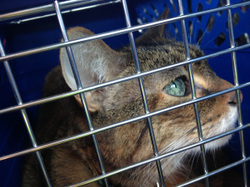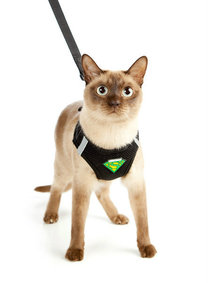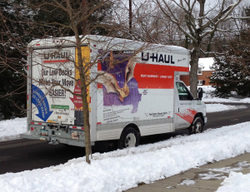 We’re moving? But I’m comfortable!
We’re moving? But I’m comfortable! by Sheila Fretwell
It was December 2012. My husband Matt had just accepted a job offer in Palo Alto and we were excited to be planning a move. Foremost on our minds was thinking about how we could safety transport our 4 cats (Pepper, Cinder, Catnip and Shivers) nearly 3,000 miles from Pittsburgh, PA to the Bay Area. Since we had some previous experience moving with our feline family, we knew we needed to start making plans right away.
Tip #1: Planning ahead is critical. Cats (although there are exceptions) are not known for being good travelers. They can become easily stressed in new and changing environments so it’s vitally important to prepare them, yourself and their environment.
The first thing you should do is ensure each cat has a comfortable carrier. The carrier must be large enough for the cat to stand up and turn around. For air travel a soft sided carrier is recommended. Purchase some puppy training pads and line each carrier with a pad. These provide cushioning and are also excellent at soaking up any accidents that might occur.
Open the carriers and scatter them around your living area well in advance of your moving day. Place toys and treats in them to get your cats' interest. The idea is to get your cats to associate the carrier with pleasant things, instead of something you only pull out when it’s time to visit the vet. When it’s time to actually put your cat in his carrier, it can be easier on both of you if you put him in butt first. If he can’t see that he’s being put in the carrier, he’s less likely to put up a fight.
It was December 2012. My husband Matt had just accepted a job offer in Palo Alto and we were excited to be planning a move. Foremost on our minds was thinking about how we could safety transport our 4 cats (Pepper, Cinder, Catnip and Shivers) nearly 3,000 miles from Pittsburgh, PA to the Bay Area. Since we had some previous experience moving with our feline family, we knew we needed to start making plans right away.
Tip #1: Planning ahead is critical. Cats (although there are exceptions) are not known for being good travelers. They can become easily stressed in new and changing environments so it’s vitally important to prepare them, yourself and their environment.
The first thing you should do is ensure each cat has a comfortable carrier. The carrier must be large enough for the cat to stand up and turn around. For air travel a soft sided carrier is recommended. Purchase some puppy training pads and line each carrier with a pad. These provide cushioning and are also excellent at soaking up any accidents that might occur.
Open the carriers and scatter them around your living area well in advance of your moving day. Place toys and treats in them to get your cats' interest. The idea is to get your cats to associate the carrier with pleasant things, instead of something you only pull out when it’s time to visit the vet. When it’s time to actually put your cat in his carrier, it can be easier on both of you if you put him in butt first. If he can’t see that he’s being put in the carrier, he’s less likely to put up a fight.
 Pepper relaxes in her carrier
Pepper relaxes in her carrier Make a few test trips with your cat(s). Take the cats with you in the car and go for a ride. Ideally have someone else drive so you can watch their reactions. Most cats will initially be very stressed but may calm down once you get on the highway and get up to highway speeds.
Watch for extreme anxiety or motion sickness. If necessary, talk to your vet about calming medications for your cat. If you decide these are necessary, it’s important to test the medicine prior to any travel; in some animals these medications can have the opposite effect and increase anxiety. Another option is a pheromone product such as Feliway. Some vets recommend these as a more natural way to help your cat stay calm.
Watch for extreme anxiety or motion sickness. If necessary, talk to your vet about calming medications for your cat. If you decide these are necessary, it’s important to test the medicine prior to any travel; in some animals these medications can have the opposite effect and increase anxiety. Another option is a pheromone product such as Feliway. Some vets recommend these as a more natural way to help your cat stay calm.

Determine your mode of travel – air vs. ground. Matt and I flew our two cats from Edmonton to Pittsburgh in 2010. Air travel is especially stressful for cats due to the loud noises and air pressure changes. Look for an airline that lets your cat travel in the cabin with you as carry on luggage. It’s safer to keep your cat with you in the passenger cabin than have him travel in the cargo hold.
Plan your route and book accommodations. Remember that it can be difficult to let your cat out of his carrier on the way. For that reason, try to plan trips that aren't more than 6 or 7 hours a day. Many hotel/motel chains will accept pets (some with an extra fee). When you book be sure they know you are bringing a cat, as some hotels have special pet rooms set aside.
A site like BringFido.com can ca be a valuable resource in finding cat friendly accommodations.
Tip #2: Adjust Feeding and Litter box schedules for the trip. Since cats tend to travel better on empty (or almost empty) stomachs, consider giving your cat a large meal before bed the night before the trip. Skip breakfast or give a very light breakfast. One of the difficulties I faced was how to get my cats to use their litter box prior to beginning the journey. Since cats tend to use a litter box right after it’s been cleaned, I would give them a tiny breakfast and clean the litter box (noisily so they could hear) while they ate. Sure enough, they all used the litter box shortly after. I would suggest adjusting the feeding schedule for travel a few days before you start your trip so your cat is accustomed to it.
Plan your route and book accommodations. Remember that it can be difficult to let your cat out of his carrier on the way. For that reason, try to plan trips that aren't more than 6 or 7 hours a day. Many hotel/motel chains will accept pets (some with an extra fee). When you book be sure they know you are bringing a cat, as some hotels have special pet rooms set aside.
A site like BringFido.com can ca be a valuable resource in finding cat friendly accommodations.
Tip #2: Adjust Feeding and Litter box schedules for the trip. Since cats tend to travel better on empty (or almost empty) stomachs, consider giving your cat a large meal before bed the night before the trip. Skip breakfast or give a very light breakfast. One of the difficulties I faced was how to get my cats to use their litter box prior to beginning the journey. Since cats tend to use a litter box right after it’s been cleaned, I would give them a tiny breakfast and clean the litter box (noisily so they could hear) while they ate. Sure enough, they all used the litter box shortly after. I would suggest adjusting the feeding schedule for travel a few days before you start your trip so your cat is accustomed to it.
 A kitty stylin' with his harness
A kitty stylin' with his harness Tips for Air Travel:
*Plan your travel so your cat has to spend the least amount of time in the carrier. Look for direct flights. If you have a significant layover, think about how you could let your cat out for water and access to a litter box. When Pepper and I flew from Edmonton to Pittsburgh we had a two hour lay over in Minneapolis. I had packed a small flattened cardboard litter box, as well as a very small amount of litter (it’s heavy). In the Minneapolis airport I found a single stall restroom with a door that locked. I was able to set up a litter box and let Pepper out of the carrier for a few minutes to use it and have a drink before we began the long leg to Pittsburgh.
*Buy a well fitted harness for your cat to wear on the trip. When you go through airport security, you will need to remove your cat from the carrier and carry her through the x-ray machine. This poses some risks and the harness can make it easier to hold onto to or catch the cat if she does squirm away.
*Even if your cat becomes stressed, try to remain calm yourself. Take off and landing are the scariest parts of the experience for your cat due to engines revving up and reverse thrusters upon landing. If you can, choose a seat as far forward in the passenger cabin as possible as noises are louder towards the back.
*Plan your travel so your cat has to spend the least amount of time in the carrier. Look for direct flights. If you have a significant layover, think about how you could let your cat out for water and access to a litter box. When Pepper and I flew from Edmonton to Pittsburgh we had a two hour lay over in Minneapolis. I had packed a small flattened cardboard litter box, as well as a very small amount of litter (it’s heavy). In the Minneapolis airport I found a single stall restroom with a door that locked. I was able to set up a litter box and let Pepper out of the carrier for a few minutes to use it and have a drink before we began the long leg to Pittsburgh.
*Buy a well fitted harness for your cat to wear on the trip. When you go through airport security, you will need to remove your cat from the carrier and carry her through the x-ray machine. This poses some risks and the harness can make it easier to hold onto to or catch the cat if she does squirm away.
*Even if your cat becomes stressed, try to remain calm yourself. Take off and landing are the scariest parts of the experience for your cat due to engines revving up and reverse thrusters upon landing. If you can, choose a seat as far forward in the passenger cabin as possible as noises are louder towards the back.

Tips for Car Travel:
*Consider traveling very early in the day when it is cooler and traffic is lighter. Avoid placing carriers in direct sunlight and don’t have air from a vent blowing directly on your cat. If possible use seat belts or bungee cords to secure the carriers so they won’t move in the event of a sudden stop or an accident.
*Keep pit stops short and sweet. Avoid leaving your cat alone in the car for anything longer than a few minutes. Do not leave them at all in hot weather – the interior of a vehicle can heat quickly to dangerous temperatures. If you are traveling alone and you must leave them for a short period, have a second set of keys so you can leave the car and air-conditioning running.
*Consider traveling very early in the day when it is cooler and traffic is lighter. Avoid placing carriers in direct sunlight and don’t have air from a vent blowing directly on your cat. If possible use seat belts or bungee cords to secure the carriers so they won’t move in the event of a sudden stop or an accident.
*Keep pit stops short and sweet. Avoid leaving your cat alone in the car for anything longer than a few minutes. Do not leave them at all in hot weather – the interior of a vehicle can heat quickly to dangerous temperatures. If you are traveling alone and you must leave them for a short period, have a second set of keys so you can leave the car and air-conditioning running.

*Avoid driving through areas where you will encounter heavy stop and go traffic. Many cats will calm at steady highway speeds but become stressed with changes in speed. If possible, stick to highways and inter-states and travel at a time of day when traffic is light.
 Pepper relaxes at the hotel after a day on the road
Pepper relaxes at the hotel after a day on the road Tips for Hotels/Motels:
*Many cats will be stressed and scared in a new environment and may hide. For this reason, I suggest releasing your cat(s) in the bathroom first. Set up the litter box, water and food in the bathroom, then set the carrier down and open the carrier door. Make sure the bathroom door is shut. Your cat may not come out immediately but eventually will venture out. Leave the carrier available for them to go back into – your cat will now likely see it as a safe familiar place that he can retreat to. If your cat is not overly fearful, you can let him or her explore the hotel room after a while. If your cat has a favorite treat, keep a bag handy. You can use that if you need to coax them out from under the bed or another hiding place.
*Many cats will be stressed and scared in a new environment and may hide. For this reason, I suggest releasing your cat(s) in the bathroom first. Set up the litter box, water and food in the bathroom, then set the carrier down and open the carrier door. Make sure the bathroom door is shut. Your cat may not come out immediately but eventually will venture out. Leave the carrier available for them to go back into – your cat will now likely see it as a safe familiar place that he can retreat to. If your cat is not overly fearful, you can let him or her explore the hotel room after a while. If your cat has a favorite treat, keep a bag handy. You can use that if you need to coax them out from under the bed or another hiding place.

*Use caution when leaving the room. Be extremely careful when opening the door. Confining your cat to the bathroom is a great option when you leave the room. It makes escape less likely. It provides a barrier - a second set of doors - if hotel staff enters the room while you’re gone. Always put the ‘do not disturb’ sign on the exterior of the room when you leave.
*Pack along some of your cat’s favorite foods and treats for the trip. A stressed cat may not have much of an appetite and is more likely to eat if you give him something he really loves. If you have the space, consider bringing a favorite blanket or throw along. Something that smells like home can help your cat calm down in an unfamiliar environment.
*Pack along some of your cat’s favorite foods and treats for the trip. A stressed cat may not have much of an appetite and is more likely to eat if you give him something he really loves. If you have the space, consider bringing a favorite blanket or throw along. Something that smells like home can help your cat calm down in an unfamiliar environment.

Seven days after we left Pittsburgh we rolled into Palo Alto. A little weary perhaps but healthy and happy. The planning and extra effort involved was completely worthwhile. We kept our family together and honored the life long commitment we made to our cats when we adopted them.
 Catnip soaks up California sunshine
Catnip soaks up California sunshine We don’t know yet where our next move will take us – across the city or across the country.
One thing we know for sure is wherever we go, our cats will be coming, too!
One thing we know for sure is wherever we go, our cats will be coming, too!

 RSS Feed
RSS Feed
